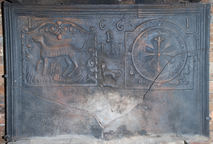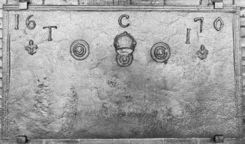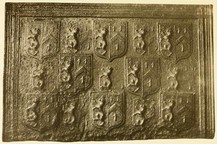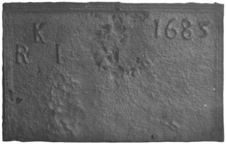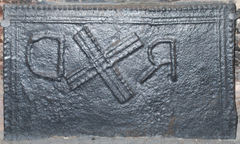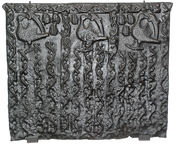-
13
Description: Rectangular; composite: complex (cavetto/cyma recta/ovolo) moulded edging (top and sides), derived from domestic carpentry; two firebacks used as patterns: on the left, rectangular with mirrored floriate scrolled top, simulated overlapping tile edging at sides, with fillet bottom edge, a mythical salamander in the form of a dog with an arrow-shaped tongue, standing among flames, a stapled scroll inside the left and right edges; on the right, arched rectangular with fillet edging indented on the inner side, surrounding a circular clock face with Roman numerals, each interspaced with a bead, and a button outside each quarter, a triangular design of swirled foliage in each bottom spandrel; initials in triad between firebacks; below, stamp formed of a talbot statant guardant upon a wreath; date split: ‘1’s in top corners, ‘6’s above initials; bottom third of fireback plain.
Notes: The talbot crest, which in this instance has been over pressed and shows the shape of the backing, is seen on other firebacks indicating a common source; the 'salamander' fireback (see no. 851) is one of the Stapled Scroll series; composite firebacks (where the impression of one or more other firebacks are used as part of the decoration) are uncommon in England but less so in France.
Inscription: 16 61 / IBM [triad]
- Decoration tags:
- rectangular (shape)
- complex, furniture-derived (edging)
- composite
- individual letters
- individual numbers
- heraldic
- mythological
- text
- animals
- objects
Manufactured: in 1661 in the Weald area of England.
Current location: in private hands, Ardingly, West Sussex, England.
- Attached to series:
- Composite firebacks
- Talbot crest series
-
201
Description: Rectangular; moulded fillet edging on top and sides; TCI, also arranged symmetrically, in a widely spaced triad; below, symmetrical layout of central rose and crown between two concentric roundels, with two fleurs-de-lys outside.
Notes: The style of rose and crown is similar to that used in gun founding in the Tudor period, suggesting that the furnace that was the source of this fireback may have been used for that purpose. Formerly at Baynards Park, Cranleigh, Surrey.
Inscription: 16 T C I [triad] 70
- Decoration tags:
- rectangular (shape)
- complex, furniture-derived (edging)
- carved stamps
- individual letters
- individual numbers
- heraldic
- royal
- text
Manufactured: in 1670 in the Weald area of England.
Current location: not known.
- Attached to series:
- 1660s-90s Wealden series
-
205
Description: Canted rectangle; simulated rectangular chain link moulded border, with bead edging inside (top and sides); Tudor royal shield surrounded by circular inscription with fillet edging; above, an English royal crown.
Notes: The unconventionality of the motto may indicate a particular purpose, e.g. thanksgiving; the edging is not known on other firebacks. Bonhams sale, Chester, 8-9 September 2009, lot 567 (£1,776).
Inscription: VIVAT·REGIN··A·DIV·:·PA CE [Long live the Queen ... peace]
Arms: Tudor royal
- Decoration tags:
- rectangular with canted top corners (shape)
- complex, furniture-derived (edging)
- carved stamps
- heraldic
- armorial
- royal
Manufactured: in the late-16th century in England.
Current location: not known.
- Attached to series:
- Tudor royal armorial firebacks
-
218
Description: Rectangular; cyma recta moulded edging formed of short lengths probably derived from furniture; top left, initials arranged in triad; top right, date; top centre, rose-and-crown between two small fleurs de lys, with two concentric rope-patterned roundels outside, above two small roses; four roses evenly spaced across lower middle, with a fleur between each outer pair, and another rose below the date.
Notes: One of a series of firebacks cast between the 1670s and 1690s bearing small, simple stamps, initials and dates; the style of rose and crown is similar to that used in gun founding in the Tudor period, suggesting that the furnace that was the source of this fireback may have been used for that purpose.
Inscription: HEM [triad] 1685
- Decoration tags:
- rectangular (shape)
- complex, furniture-derived (edging)
- simple stamps
- carved stamps
- individual letters
- individual numbers
- heraldic
- royal
- text
- objects
Manufactured: in 1685 in the Weald area of England.
Current location: Brighton Museum and Art Gallery, Brighton, East Sussex, England.
Museum number: R3341/2 (part of the Brighton Museum museum group)
Citation: Gardner, J. S., 1898, 'Iron Casting in the Weald', Archaeologia, 56, 1, pp. 133-164.
Citation: Lindsay, J. S., 1927, Iron & Brass Implements of the English House (London, The Medici Society).
- Attached to series:
- 1660s-90s Wealden series
- Fleur-de-lys firebacks
-
202
Description: Rectangular; edging formed from furniture moulding; shield of Ayloffe impaling Sulyard impressed weakly seven times (2-3-2), with the same shield impressed eight times (3-2-3), more deeply, in the spaces between the first shields.
Notes: William Ayloffe (c1535-1584) of Bretons, Hornchurch, Essex, Justice of the Court of Queen’s Bench, married (c1560) Jane, dau. of Sir Eustace Sulyard, of Runwell, Essex. A large number of variants use the same shields. Several copies are known of this fireback, but in precisely the same arrangement, all poorly cast, unlike the variants without the additional shields, which are found in many different arrangements, some with dates and initials. From an illustration in the catalogue of an exhibition on heraldry at Burlington House, London, in 1894, it then being at Manor Farm, Edenbridge, Kent.
Copies of this fireback are known.
Arms: Ayloffe impaling Sulyard (William Ayloffe of Bretons, Hornchurch)
- Decoration tags:
- rectangular (shape)
- complex, furniture-derived (edging)
- carved stamps
- heraldic
- armorial
Manufactured: in the early-17th century in the Weald area of England.
Current location: not known.
- Attached to series:
- Ayloffe series
- Personal armorial firebacks
-
1050
Description: Rectangular; triple-moulded edging (top and sides); top left, initials RKI in triad; top right, date.
Notes: The initials probably relate to a husband and wife, the top initial being that of their surname. Formerly part of the J. H. Every collection.
Inscription: RKI [triad] 1683
- Decoration tags:
- rectangular (shape)
- complex, furniture-derived (edging)
- carved stamps
- individual letters
- individual numbers
- text
Manufactured: in 1683 in the Weald area of England.
Current location: Anne of Cleves House, Southover High Street, Lewes, East Sussex, England.
Museum number: LH000.921 (part of the Sussex Archaeological Society museum group)
- Attached to series:
- 1660s-90s Wealden series
-
490
Description: Rectangular; multiple moulding on top and sides; inscription below moulding at top; three pointed crosses, one between inscription and date, one each side of date.
Notes: Purchased by J. H. Every in a sale at Groombridge Place, Kent in 1919. John Rivers was the husband of Isabella Packer, whose father Sir Thomas Packer, owned Groombridge Place. Bequeathed to the Sussex Archaeological Society in 1944.
Inscription: IOHN·RIVERS / 1643
- Decoration tags:
- rectangular (shape)
- complex, furniture-derived (edging)
- carved stamps
- individual letters
- individual numbers
- text
Manufactured: in 1643 in the Weald area of England.
Current location: Michelham Priory, Arlington, East Sussex, England.
Museum number: 1944.24.431 (part of the Sussex Archaeological Society museum group)
Citation: Hughes, G. B., 21 Apr 1955, 'Old English Firebacks', Country Life, 117, pp. 1056-60.
Citation: Hughes, G. B., May 1940, 'Old English Firebacks', Apollo, 31, 185, pp. 117-120.
- Attached to series:
- Personal firebacks
- Miscellaneous stamp firebacks
-
664
Description: Rectangular; moulded border with bead edging derived from wooden strips (top and sides); top left, a saltire of the same moulding as the border, between roughly shaped D and R, both reversed.
Notes: The border appears to be in pieces of different lengths, probably from redundant furniture. Illustrated by Christy, 1908, in the possession of Mr E. Simmons of Lewes.
Inscription: D R
- Decoration tags:
- rectangular (shape)
- complex, furniture-derived (edging)
- simple stamps
- individual letters
- apotropaic
- text
- objects
Manufactured: in the early- to mid-16th century in the Weald area of England.
Current location: in private hands, Rolvenden, Kent, England.
- Attached to series:
- Initials only firebacks
-
906
Description: Rectangular; cyma recta moulded edging in short lengths (top and sides, with gap at bottom of each side); top centre, rose and crown between four small fleurs-de-lys (2 over 2); date split in top corners, with concentric roundel inside, next to upper fleurs; below date, concentric roundel, with small rose inside, next to lower fleurs; the whole arrangement symmetrical.
Notes: The only example of this series with no initials; one vertical plankline. The style of rose and crown is similar to that used in gun founding in the Tudor period, suggesting that the furnace that was the source of this fireback may have been used for that purpose.
Inscription: 16 85
- Decoration tags:
- rectangular (shape)
- complex, furniture-derived (edging)
- simple stamps
- carved stamps
- individual numbers
- planklines
- heraldic
- royal
- text
- objects
Manufactured: in 1685 in the Weald area of England.
Current location: in private hands, Upper Beeding, West Sussex, England.
- Attached to series:
- 1660s-90s Wealden series
- Fleur-de-lys firebacks
-
735
Description: Rectangular; three birds (probably swans, a Lancastrian badge) turned to the left, their heads facing right, and the front edge of their left wing extended and inverted; vine pattern strips, one horizontal along the top, and 14, of varied length, vertically across the rest of the fireback; seven ‘grape bunch’ shapes with criss-cross markings, arranged in three groups — 3-1-3 — adjacent to the birds.
Notes: The same vine strips are found on several firebacks, including some of the ‘Anne Forster’ series; the birds are also seen on a number of firebacks; the ‘grape bunch’ shapes may be the same as those on the ‘Anne Forster’ graveslab in Crowhurst church, Surrey. John Starkie Gardner and later writers attributed the birds to an association with the Fowle family; this is unlikely to be correct as the Fowles came to prominence in the iron industry towards the end of the sixteenth century and had their own distinctive decorative emblems. Formerly in the collection of Lady Dorothy Nevill.
- Decoration tags:
- rectangular (shape)
- complex, furniture-derived (edging)
- simple stamps
- carved stamps
- animals
- objects
Manufactured: in the mid- to late-16th century possibly at Pounsley Furnace, Framfield in the Weald area of England.
Current location: Victoria & Albert Museum, Cromwell Road, Kensington & Chelsea, Greater London, England.
Museum number: M.120-1914 (part of the Victoria & Albert Museum museum group)
Citation: Dawson, C., 1903, 'Sussex Iron Work and Pottery', Sussex Archaeological Collections, 46, pp. 1-54.
Citation: Gardner, J. S., 1898, 'Iron Casting in the Weald', Archaeologia, 56, 1, pp. 133-164.
Citation: Straker, E., 1931, Wealden Iron (London, Bell).
- Attached to series:
- Pounsley series
- Vine strip series
- Swan series
- Furniture stamp firebacks
